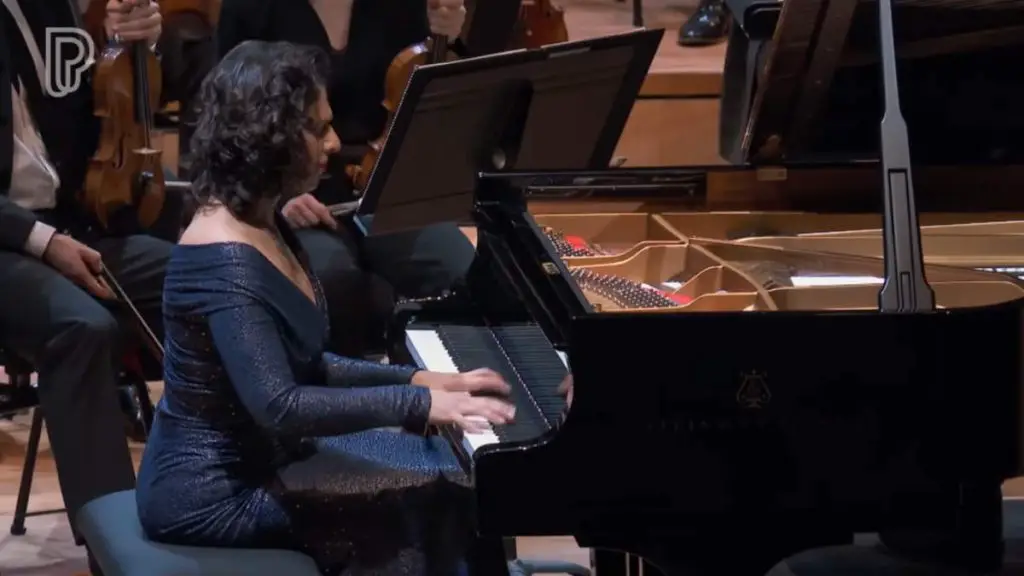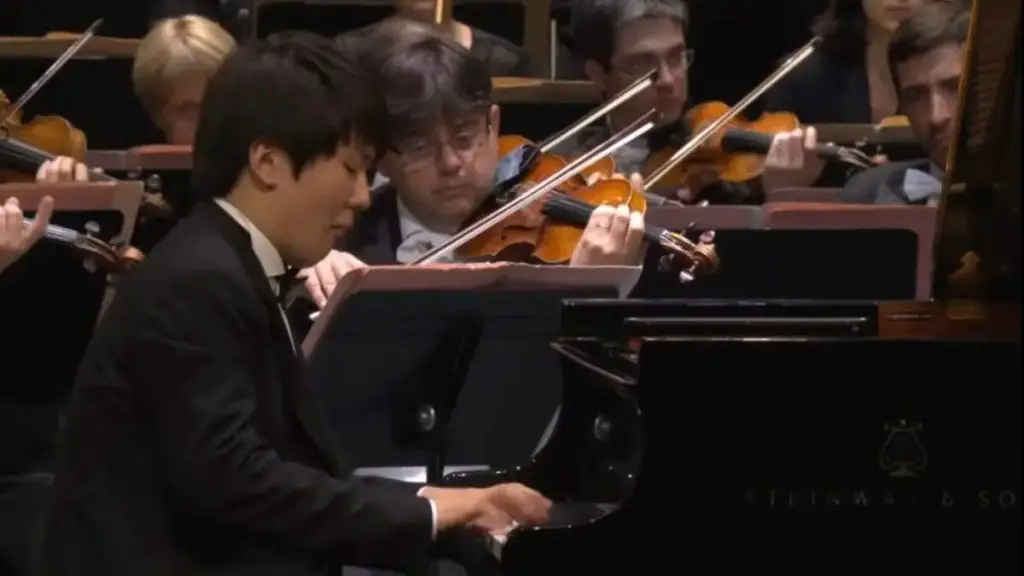Accompanied by the Finnish Radio Symphony Orchestra, the Chinese classical pianist Yuja Wang performs Pyotr Ilyich Tchaikovsky’s Piano Concerto No. 1 in B-flat minor, Op. 23. Conductor: Hannu Lintu. Recorded at the Helsinki Music Centre Concert Hall on September 7, 2012.
Tchaikovsky’s Piano Concerto No. 1
Tchaikovsky’s Piano Concerto No. 1 in B-flat minor, Op. 23, is one of the most famous and frequently performed concertos in the classical piano repertoire. Composed between November 1874 and February 1875, this concerto is celebrated for its beautiful melodies, emotional depth, and technical challenges. It showcases Tchaikovsky’s ability to blend stunning virtuosic passages for the solo piano with rich orchestral textures, creating a work of grandeur and intensity.
The concerto opens with one of the most iconic introductions in the piano concerto literature-a powerful and majestic theme played by the piano and supported by the orchestra, immediately capturing the listener’s attention. This theme, while memorable, does not reappear throughout the concerto, serving instead as a dramatic opening to the vast musical narrative that unfolds. Tchaikovsky’s concerto moves through a wide range of emotions, from passionate and fiery to tender and introspective.
The premiere of the concerto was met with mixed reactions. Initially, it was offered to the renowned pianist Nikolai Rubinstein, Tchaikovsky’s friend and mentor, who harshly criticized it. This response deeply hurt Tchaikovsky, who nevertheless refused to make the substantial changes Rubinstein suggested. The concerto was eventually premiered in Boston, Massachusetts, by pianist Hans von Bülow, to whom Tchaikovsky dedicated the work, and it received much acclaim. Over time, it gained popularity and became a staple of the piano concerto repertoire.
Tchaikovsky’s Piano Concerto No. 1 breaks away from the traditional concerto form in several ways, showcasing the composer’s innovative approach to structure and melody. Despite Rubinstein’s initial criticism, he later reversed his opinion and became one of the concerto’s champions, performing it frequently.
The concerto’s enduring popularity can be attributed to its memorable melodies, emotional richness, and the virtuosic demands it places on the soloist, offering a showcase for pianists to demonstrate both technical skill and deep musicality. Its dramatic opening, lyrical passages, and spirited themes ensure its place as a beloved work in the classical music canon, enchanting audiences worldwide with its beauty and power.
The title cut from Pink Martini’s 2009 album Splendor in the Grass employs the famous theme from the first movement.
Movements
1. Allegro non troppo e molto maestoso – Allegro con spirit
The first movement of Tchaikovsky’s Piano Concerto No. 1 in B-flat minor, Op. 23, is marked “Allegro non troppo e molto maestoso – Allegro con spirito.” This movement is notable for its dramatic opening, emotional depth, and technical brilliance, setting the tone for the entire concerto.
It begins with one of the most famous introductions in the concerto repertoire: a powerful and majestic theme played by the piano, accompanied by fortissimo chords from the orchestra. This theme, characterized by its broad, sweeping melody, is striking and memorable, creating an immediate impact. Interestingly, this grand opening theme doesn’t reappear later in the movement or the concerto, serving instead as a grandiose introduction to the musical journey ahead.
After this dramatic introduction, the movement transitions into the main body, marked “Allegro con spirito.” Here, Tchaikovsky introduces a series of themes that are developed and intertwined throughout the movement. The piano and orchestra engage in a dynamic dialogue, with the solo piano part weaving through virtuosic passages, lyrical melodies, and fiery sequences. The movement showcases the soloist’s technical skill and emotional expressivity, with demanding runs, arpeggios, and chords.
The structure of the first movement is somewhat unconventional. Tchaikovsky deviates from the traditional sonata form commonly used in concerto first movements. Instead, he presents a more free-flowing, episodic structure that allows for the development of thematic material in a variety of emotional and musical contexts. This approach enables a rich exploration of the concerto’s thematic ideas, offering a blend of virtuosity and lyricism.
The movement culminates in a thrilling coda, where the solo piano part becomes increasingly virtuosic, leading to a powerful and triumphant conclusion with the orchestra. This conclusion brings the movement to a close with a sense of grandeur and excitement, leaving a lasting impression on the listener.
2. Andantino semplice – Prestissimo – Tempo I
The second movement of Tchaikovsky’s Piano Concerto No. 1 in B-flat minor, Op. 23, is a striking contrast to the grandiosity and intensity of the opening movement. This movement, marked “Andantino semplice,” offers a moment of serene beauty and introspective calm. It serves as a lyrical interlude between the vigorous outer movements, showcasing Tchaikovsky’s gift for melody and his ability to evoke deep emotion through simplicity.
The movement opens with a delicate and simple melody played by the flute, setting a tranquil and somewhat dreamlike atmosphere. This melody is then taken up by the piano, which elaborates on it with gentle grace and subtle expressiveness. The intimacy of this section is one of its defining features, with the piano engaging in a tender dialogue with the orchestra.
A central section, marked “Prestissimo,” temporarily shifts the mood. Here, the music becomes more animated and whimsical, providing a contrast to the opening theme’s calmness. This section features a light and fluttering passage that demands agility and precision from the pianist, showcasing the soloist’s technical skills in a different light.
After this lively interlude, the movement returns to the main theme, restating the tranquil melody with renewed warmth and depth. The reprise is often more embellished, allowing the soloist to bring a personal interpretation to the melody’s return. The movement concludes softly, with the piano and orchestra gently subsiding, leaving a lingering sense of peace and contemplation.
3. Allegro con fuoco – Molto meno mosso – Allegro vivo
The third movement of Tchaikovsky’s Piano Concerto No. 1 in B-flat minor, Op. 23, is a vibrant and exhilarating conclusion to the concerto. Marked “Allegro con fuoco,” this movement is characterized by its energetic rhythms, brilliant piano writing, and a triumphant spirit that brings the work to a dazzling close.
This final movement opens with a vigorous and rhythmic theme introduced by the orchestra, immediately setting a dynamic and spirited tone. The piano soon joins with a cascade of virtuosic passages, embarking on a thrilling musical journey that showcases the soloist’s technical prowess and interpretative skills. The movement is structured around several contrasting themes that Tchaikovsky weaves together with masterful orchestration, creating a rich tapestry of sound that is both cohesive and varied.
One of the most notable aspects of the third movement is its use of Ukrainian folk melodies, which Tchaikovsky incorporates into the fabric of the music. These folk elements add a distinctive color and vitality to the movement, reflecting the composer’s interest in and affection for folk music. The main theme, with its rhythmic drive and memorable melody, recurs throughout the movement, serving as a unifying thread amid the diverse musical material.
The interaction between the piano and the orchestra is particularly compelling in this movement. Tchaikovsky skillfully balances soloistic brilliance with orchestral grandeur, allowing moments of delicate interplay to alternate with full-throated, orchestral tuttis. The piano part is replete with challenges, including rapid scales, arpeggios, and octaves, demanding a combination of virtuosity, stamina, and musicality from the performer.
As the movement progresses, the music builds in intensity, leading to a climactic finale that reiterates the main theme with even greater force and enthusiasm. The concerto concludes with a series of triumphant chords from the piano, echoed by the orchestra, bringing the work to an exhilarating and satisfying end.
Sources
- Piano Concerto No. 1 on the Tchaikovsky Research website
- Piano Concerto No. 1 (Tchaikovsky) on Wikipedia
- Piano Concerto No. 1, Op.23 (Tchaikovsky, Pyotr) on the International Music Score Library website




